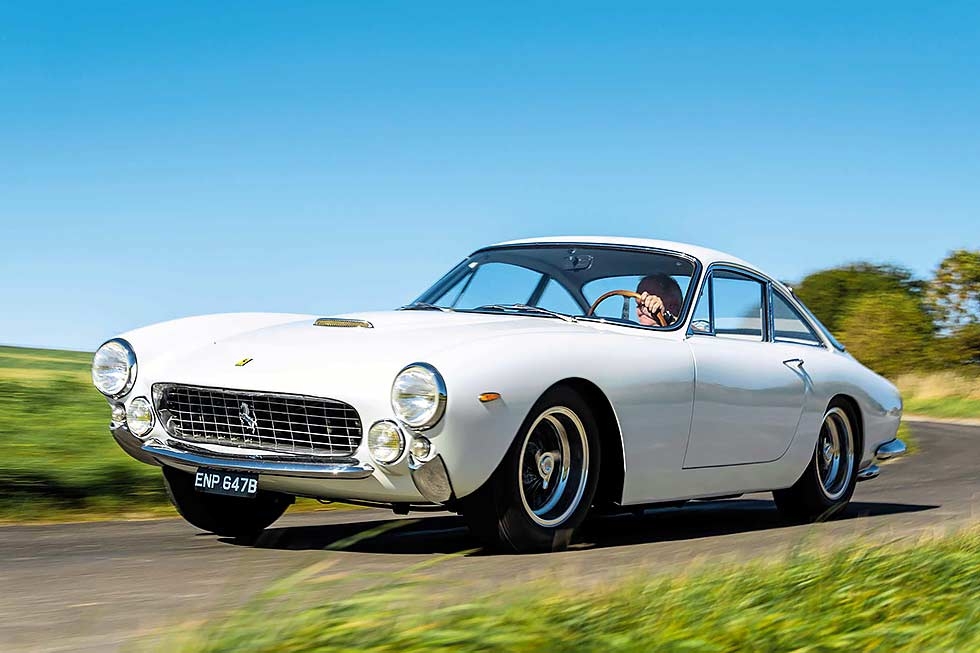
Ferrari Lusso. The ultimate blend of beauty and beast? The 250 GT Lusso is one of the most glamorous of all Ferraris, and this example, painted white at the behest of former owner DJ Chris Evans, is as striking as they come. Words John Simister. Photography Tim Andrew.
RHAPSODY IN WHITE COVER STORY Ferrari 250 GT Berlinetta Lusso
It’s white. With an interior trimmed in light blue leather. This is not how you would expect a Ferrari 250 GT Lusso to be, but in the high-net-worth world of Ferrari ownership, what Sir wants is what Sir shall have.

The other stand-out features of this Lusso are as expected, though, provided you knew what to expect in the first place. If you did not, then aesthetic surprises are in store as soon as you open the driver’s door. It’s all about the dials. The two biggest and most useful ones – and they really are unusually big, like an early Mini’s speedometer – are positioned not dead-ahead, framed by the large Nardi wood-rimmed steering wheel, but over to your right in this left-hand-drive car.
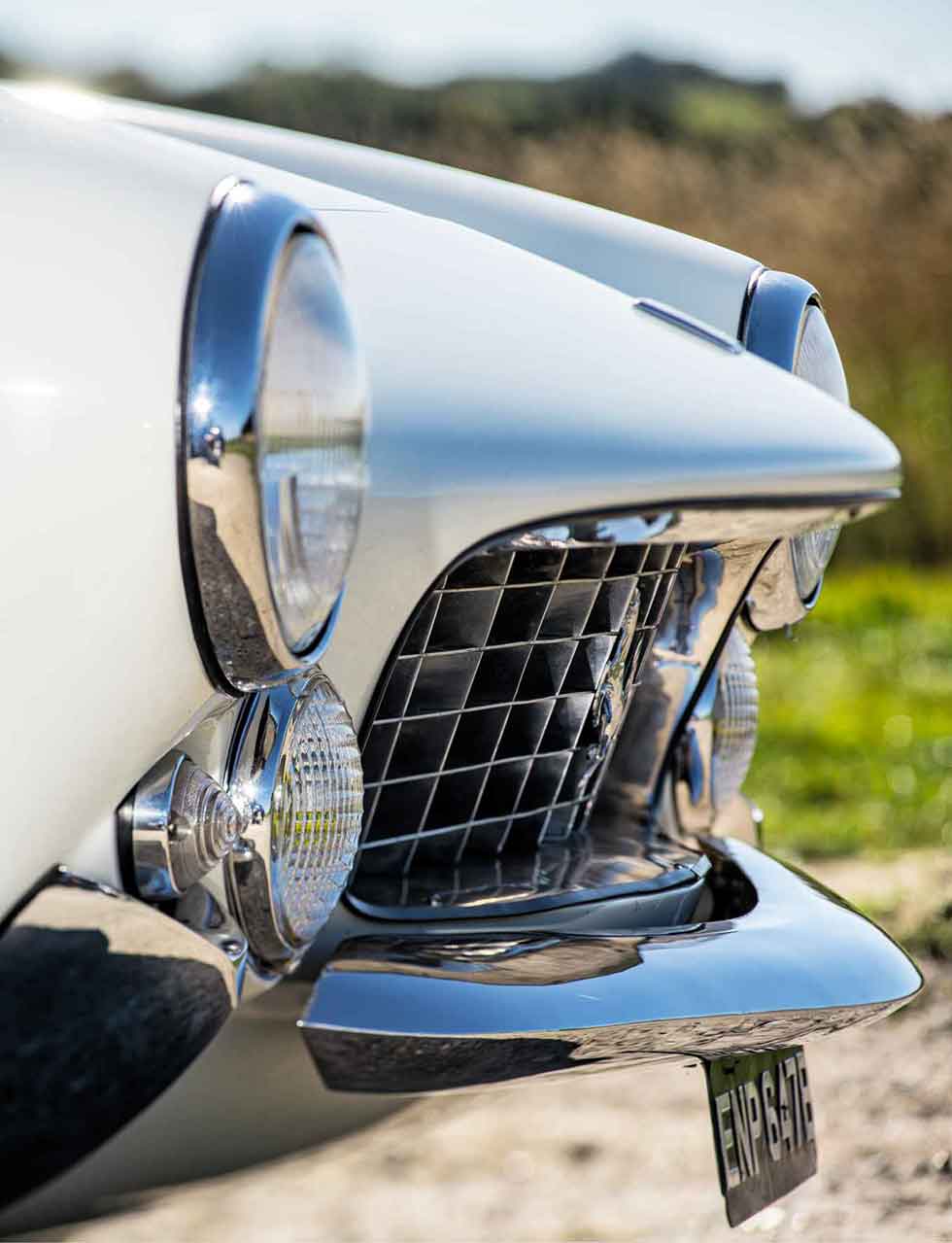
‘The Lusso was the last Ferrari road car to use Colombo’s F12 in its most famous “250” form’
The rev-counter, always central to a Ferrari’s being, sits appropriately bang in the middle of the dash. The speedometer, of secondary importance when cars were cars and open roads had no speed limits, is to the tacho’s right, beyond the easy sweep of the driver’s subconscious vision, although well-placed to inform a nervous passenger. At least both are angled, slightly, towards the driver.
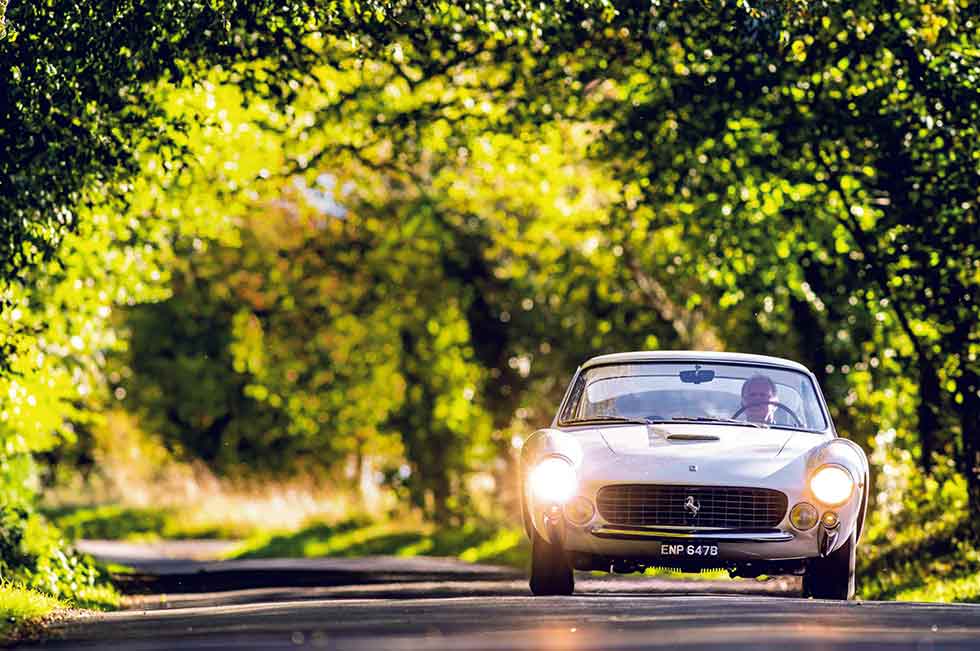
So, the white. You might have heard of a red-headed DJ, and briefly Top Gear presenter, called Chris Evans. He has been a prodigious collector of fast and valuable cars, and the instigator of northern and southern versions of a grand car gathering called CarFest. He decided not only to acquire seven highly desirable classic Ferraris but also to have them all painted white, with blue leather inside. Ferrari specialist Talacrest found the cars and masterminded the colour changes.
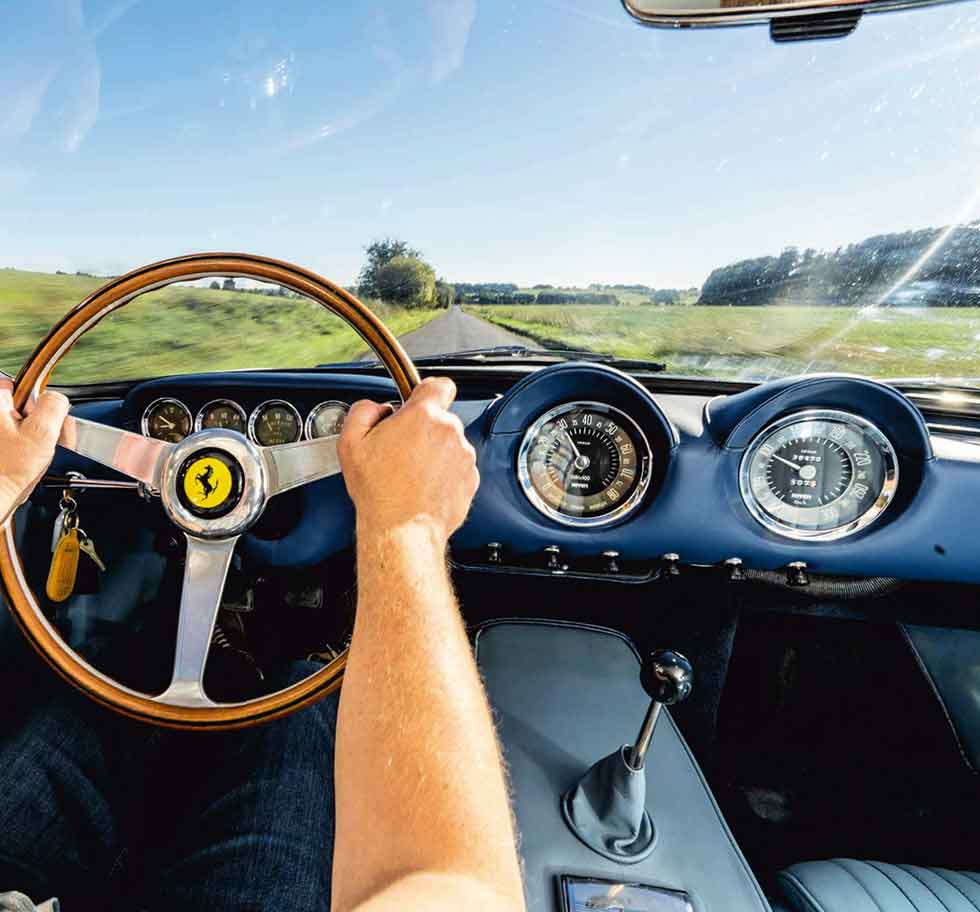
The Lusso’s own colour transformation came in 2008, a process applied also to a Dino, a 288 GTO, a 275 GTB, an F40, a 250 GT SWB and a 250 Testa Rossa recreation. Suitable ENZ registration numbers were acquired for them, although this County Londonderry series was current a long time after these Ferraris were new. Normally a car can’t bear a number newer than the car itself, but perhaps the rules are different with Northern Irish plates.
A year or so later, Evans decided he didn’t want to keep all these white Ferraris and started to sell the collection. Talacrest re-acquired the Lusso in 2009, and it’s now for sale again bearing a correct, age-related 1964 numberplate. Does the kudos of having had a famous owner and a high public profile add as much to its value as its non-original colour scheme might reduce it? Does the latter matter in this part of the market? After all, it’s still a 1964 Lusso and, to some eyes, classic Ferraris come no more delicious than this. And we’re about to taste this delicacy for ourselves.
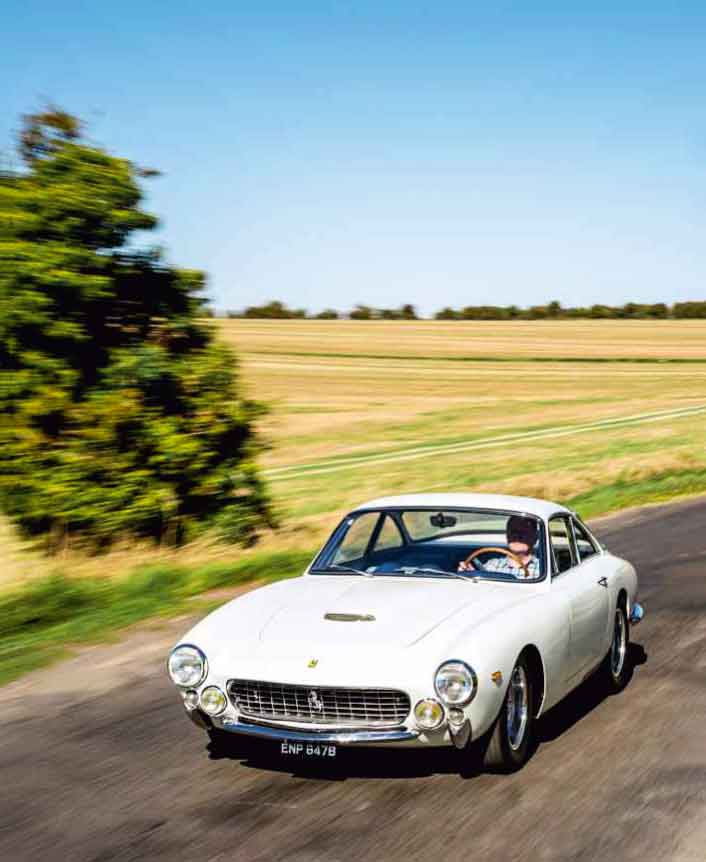
Before we do that, though, it’s interesting to reflect on this car’s pre-Evans life. John Collins, owner of Talacrest, told us that it was red with a black interior as bought in 2008 with the White Collection in mind, but was originally dark metallic blue with, yes, a blue interior, although not necessarily in the shade of the current one. It’s a matching-numbers car that has resided in several European countries, and prior to gaining its white paint finish it underwent a body-off, nut-and-bolt restoration. So it should be as pristine as a Lusso can be.
The Lusso, also known as GT/L, had a short production life. Ferrari revealed it at the 1962 Paris show, the first of 351 production examples was built in January 1963 (1963 Ferrari 250 GT Berlinetta Lusso comparison test) and the last was completed in August 1964, the year this white car was built in blue. It was the last Ferrari road car to use Gioachino Colombo’s V12 engine in its most famous ‘250’ form, each highly oversquare cylinder occupying 246cc (so almost 250), the two valves in each cylinder actuated by its bank’s single overhead camshaft.
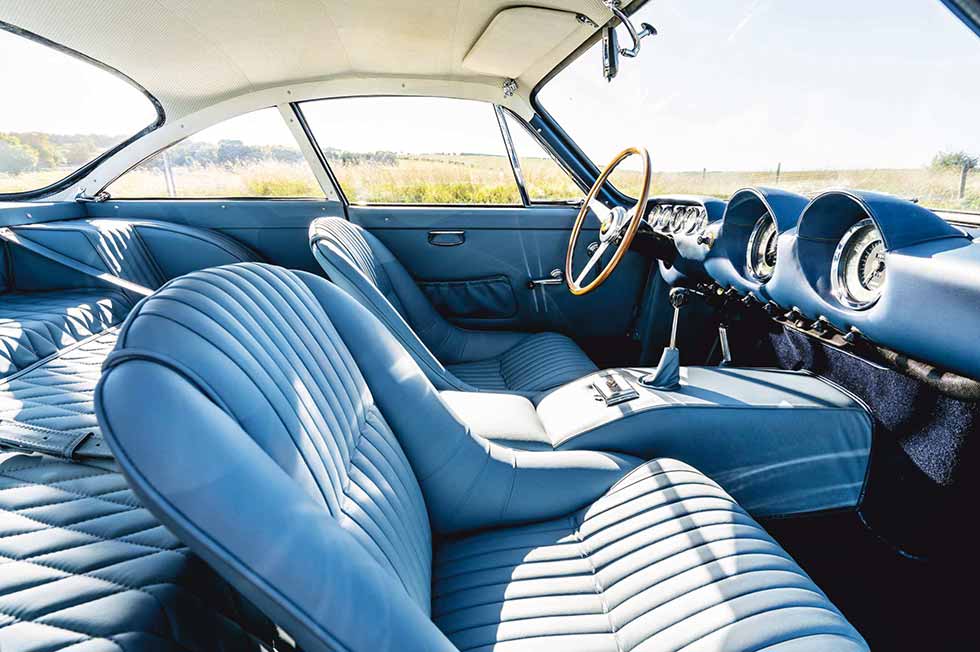
The chassis, too, followed the pattern of other 250-designated Ferraris such as the GT SWB and GTO, albeit formed of slightly less substantial tubes. Despite the longer, more expansive curves of its Pininfarina-shaped, Scaglietti-built body, the Lusso retained the short wheelbase of its racier siblings. It’s not the two-plus-two it looks as if it could be, but it does have a roomier, airier cabin enabled partly by mounting the V12 slightly further forward. The fact that the tail is longer means the weight distribution remains almost even front-to-rear.
Aside from that magnificent engine, there’s nothing especially glamorous or innovative about the Lusso’s mechanical make-up. That’s how Ferrari road cars were back then. Enzo contended that it was all about the engine, preferably a V12. So we have a live axle with leaf springs at the back, tied down by radius rods and a transverse Watt’s linkage, and an old-fashioned steering box, albeit of the most precise, most efficient variation of the genre, a worm-and-roller. Koni dampers – great in the 1960s, still great today – control the body movements. What such simplicity can mean is an easy, benign predictability in the way a car drives, all the better for the trans-European blasts for which the Lusso was created.

So, what do you think of the shape? Beautiful, or not quite right? To a childhood me, the owner of a Matchbox model in bright metallic green, the Lusso seemed the sleekest, suavest of Ferraris, those wide-rimmed, deeply dished, wire-spoked Borranis adding raciness to the smooth, unadorned curves. The huge glass area and slender pillars lend a lightness to the form, suggesting pace and agility rather than brute power and strength. And at the tail we find possibly the first roadgoing application of a rear spoiler, a gentle kick- up above the vertical transom with its pair of round tail-light units.
‘Power just builds as the revs soar and the soundscape becomes the full Goodwood’
If this tail is a pointer to that of the 275 GTB that followed, the nose looks the other way on the timeline. It resembles the 250 GT SWB’s, with a rounded-rectangular latticework grille set low between prominent headlights. Except that here the extra front lights are set not within the grille but just outboard of it, and there’s an aesthetically pleasing but functionally almost pointless bumper below it. This doesn’t extend to the corners, which instead bear separate vertical bars to give a visual if not actual notion of bash-protection. At the Lusso’s aft end, by contrast, we find a full, complete, wraparound bumper.

Now, the tricky bit. The Lusso’s form includes wheelarches shaped with very specific, varying-radius curves, the resulting aperture squarer for the rear ‘arches than for the fronts. These shapes are central to the Lusso look, as is the curve of the sill that joins them. Scaglietti’s metalworkers knew instinctively how the shapes should be, how the tension they create holds together a shape that could otherwise deconstruct into several slightly unsatisfactory aspects. Without that tension, the nose section could appear a bit too bulbous and droopy, and your eye, deprived of harmony and flow, would be drawn to the incongruous convexity and misalignment of the rear side window’s lower edge.

Trouble is, over the years these cars have inevitably had bodywork repairs, restorations even, and some of this subtlety gets lost. And when a car is bright white, there is no hiding place. It’s hardly alone in this, but our Lusso here has slightly lost the look, more on one side than the other. Or maybe it has always been this way; handmade bodies often vary.
All seems just as it should be inside, though. The re-trim is exquisite, right down to the quilted leather of the luggage platform behind the seats and the matching straps to stop your suitcases sliding around as you tackle yet another Alpine pass. As the luxury model, which is what ‘Lusso’ means, this Ferrari might be expected to have reclining seats, but no: instead, the huge, flat-topped centre tunnel is flanked by a pair of racy buckets. If you need to tailor the relationship of seat to steering wheel to floor-hinged pedals, then there are two inches of pedal adjustability to complement the usual seat slider.
Installed in one of those seats, I have straight ahead of me a bank of five dials. Later I’ll discover that the oil-pressure gauge is the only one to give a credible reading; the Lusso will run out of petrol despite a quarter-tank showing on the gauge, the dials for temperatures of oil and water barely move, and the clock is frozen in time. All can be fixed, of course, and no doubt will be in due course. They are probably the result of the Lusso’s lack of recent vigorous use.
‘This car could well have a bit more than the standard 240bhp’
The dials do look good, though, their promise of a window into the Ferrari’s workings designed to appeal to those for whom mechanisms are fascinating and important. Another important-looking row, this one of unlabelled switches, stretches across the dashboard’s centre section, and out of a bell-like protruberance on the left side of the steering column sprout stalks for the indicators and headlight dipping. With its knurled nut to hold the stalks’ mechanism in place, this ‘bell’ reminds me of the similar items (it had two) in a sporting Italian coupe I once owned: a Lancia Fulvia HF.
The V12 fires easily. It sounds busy, the rustle of valvegear and the whine of chains overlaying the exhaust note’s rich hum. The induction side is vocal, too, there being no air filters to dampen it. Mesh alone protects the six otherwise-open carburettor trumpets, attached here to Weber 40 DCZ6 carburettors rather than the usual filter-covered 36 DCS units. It was common practice for customers to specify an upgrade or two when ordering their Lusso to give it a harder edge, which means this car could well have a bit more than the standard 240bhp.

I accelerate away, first gear revealing the very long legs that go with just four forward ratios, a maximum speed on the far side of 140mph (around 7000rpm) in the highest of them, and the need not to have unworkably large gaps between each pairing. Peak torque (205lb ft) doesn’t arrive until 5500rpm, and peak power at a mad-for-1964 7500rpm, but there’s plenty of pull at lowish engine speeds provided you don’t open the six throttles fully below 2500rpm. And when a gearshift is required, the lever’s action is a paragon of metallic precision, helped by a light, smooth but occasionally slip-prone clutch.
Quite a lot of smoke emerges from the tailpipes, handsome with their red-painted inner surfaces and turbo-vane surrounds, while the engine is getting to its optimum temperature, but soon it clears and the open road beckons. There’s no specific point in the rev-range when power suddenly pours in; it just builds and builds as the revs soar and the soundscape becomes the full Goodwood. At 6000rpm – visited by me only briefly because it’s not my car, and not exceeded – the V12 is… what? Howling? Screaming? Whatever, it revs up the human viscera in a way few other sounds manage, emboldened by a mechanical frisson too metallic and too explosive to be smooth, but indicative of perfect mechanical balance.
‘This Lusso begs to be used. It’s what keeps old Ferraris fit and healthy’
So Enzo’s insistence on the engine as the main event is satisfied here, even if the Lusso doesn’t always feel as fast as it sounds. (You just press ever further into the accelerator pedal’s long travel to remedy that.) But the other stuff is important, too: the steering, the ride, the handling, the brakes. And as speculated on earlier, all are straightforwardly satisfying.

The front suspension is firm, the rear less so, which means the Lusso leans in corners in a way that emphasises the sensation of pointing around the bend. It sits nicely on the outside rear wheel as you power through, the steering getting lighter as you finish the bend with a flourish of gentle, easily and minutely controllable oversteer. It’s not a slide or a slither, just a throttle-controlled line adjustment. And it’s lovely.
Even when you’re not helping it with the engine’s torque, the steering, heavy in earlier car-park manoeuvres, is light, talkative and accurate enough to mask the slight play at the rim typical of a steering box. The brakes, Dunlop discs all round, are as strong and powerful as you’d hope.
This 250 GT Lusso is so nearly a great car. Were you to buy it and use it regularly, you’d want its few non-functionalities righted, as they surely will be, and its driving greatness would then be complete. It begs to be used, because that’s what keeps old Ferraris – indeed, all old cars – fit and healthy. No-one thought of collecting and investing in Ferraris back in 1964. If you had one you just drove it, and savoured every minute.
I’d love to do that with this Lusso. And perhaps have it repainted in dark metallic blue.
TECHNICAL DATA FILE SPECIFICATIONS 1964 Ferrari 250 GT Berlinetta Lusso
ENGINE V12, 2953cc
MAX POWER 240bhp @ 7500rpm / DIN nett
MAX TORQUE 205lb ft @ 5500rpm / DIN nett
TRANSMISSION Four-speed manual, rear-wheel drive
SUSPENSION Front: double wishbones, coil springs, telescopic dampers, anti-roll bar. Rear: live axle, trailing arms, semi-elliptic leaf springs, telescopic dampers
STEERING Worm-and-roller, unassisted
BRAKES Solid discs front and rear
WHEELS 7 x 15in wire-spoke
TYRES 185 VR15
WEIGHT c1100kg
POWER TO WEIGHT c220bhp/ton
0-60MPH c8.0sec
TOP SPEED c150mph
PRICE NEW £5606 (£120,000 in today’s money)
VALUE TODAY £1.5 million+






